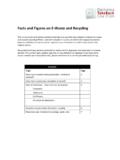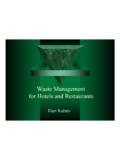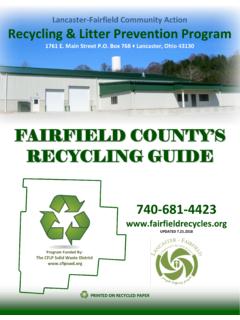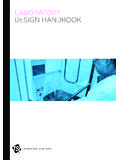Transcription of E-Waste Management - cpcbbrms.nic.in
1 E-Waste Management E-Waste is one of the fastest growing waste streams in our country. It ranges from to 1% of the total household waste generation. E-Waste contain toxic constituents such as lead, cadmium, mercury, polychlorinated bi-phenyls (PCBs), etched chemicals, brominated flame retardants (BFR), arsenic, asbestos and nickel etc. and also recoverable materials such as silver, gold, platinum, palladium, copper, aluminium, iron and plastics etc. E-Waste in its non-dispersed form is not a threat to environment, however, any attempt to recover useful material from dismantled/dispersed E-Waste without having environmentally sound recycling/processing facilities will adversely affect human life and environment. A study to assess E-Waste generation based on obsolescence rate and installed base in India taken up by CPCB in the year for the year 2005 indicates a generation of 146180 tonnes per annum. It was estimated that it will exceed 8, 00,000 tonnes by 2012.
2 It was also found that sixty-five cities in India generate more than 60% of the total E-Waste generated in India. Ten states generate 70% of the total E-Waste generated in India. The study covered market size and growth for Information and Communication Technology (ICT), TVs (brown goods), refrigerators and washing machines (white goods), which are expected to drive the future growth of electronics hardware industry in India. It was estimated that the obsolescence rate for computers is seven years and fifteen years for TVs, washing machines and refrigerators. Existing Scenario MoEF and CPCB have brought out guidelines for environmentally sound Management (ESM) of E-Waste . The guidelines were notified by MoEF in March 2008. The guidelines provide comprehensive framework for E-Waste collection, transportation, recycling and disposal. E-Waste recycling based on environmentally sound recycling principles is permitted under The Hazardous waste ( Management , Handling & Transboundary Movement) Rules, 2008.
3 As an outcome of this regulatory intervention, forty seven (47) E-Waste recycling facilities were granted registration till August, 2011. The total recycling capacity of these registered recyclers is approximately 2, 18,236 MTA. However, the quantity of E-Waste being re-recycled by these facilities is far less (about 50 % of the total E-Waste generation in India) compared to actual generation in the country. The main concern in E-Waste Management in the country is due to illegal handling and recovery operation by unorganized sector adopting crude recycling and reuse, thereby causing sever environmental damage and health risks. In May, 2011 MoEF has notified the E-Waste ( Management & Handling) Rules, 2011 which will be effective from 1st May, 2012. Till the time, the new rule takes effect; the Management of E-Waste is being governed by HW (M, H & TM) Rules, 2008 where E-Waste has been included in the schedule IV of the said Rules.
4 These rules shall apply to every producer, consumer involved in the manufacture, sale, and purchase and processing of electrical and electronic equipment or components as specified in schedule I. In the schedule, only two categories of electrical and electronic equipments have been covered. They are given below: Information Technology and Telecommunication Equipment: o Centralized data processing o Mainframes, Minicomputers o Personal Computing o Personal Computers (Central Processing Unit with input and output devices) o Laptop Computers(Central Processing Unit with input and output devices) o Notebook Computers o Notepad Computers o Printers including cartridges o Copying Equipments o Electrical and Electronic Typewriters o User Terminals and Systems o Facsimile o Telex o Telephones o Pay Telephones o Cordless telephones o Cellular telephones o Answering Systems Consumer Electricals and Electronics o Television Sets {including sets based on(liquid Crystal Display and Light Emitting Diode Technology)},refrigerator, Washing Machine, Air Conditioners excluding centralized air conditioning plants In these rules Extended Producer Responsibility (EPR) has been introduced where the responsibility of collection of E-Waste has been placed with the producer.
5 As per these rules, every producer of electrical and electronic equipment listed above, collection centre, dismantler and recycler of E-Waste shall obtain an authorisation from the SPCBs/PCCs. Also every dismantler or recycler of E-Waste will seek registration from SPCBs/PCCs for dismantling and recycling of E-Waste . These rules allow storage of E-Waste by every producer, collection centre, dismantler or recycler for a period not exceeding one hundred and eighty days and they also have to maintain a record of collection, sale, transfer, storage and segregation of wastes. Regarding hazardous material in the component of electronic and electrical equipments the maximum concentration value of by weight in homogenous materials for lead, mercury, hexavalent chromium, polybrominated biphenyls or polybrominated diphenyl ethers (PBDE) and by weight in homogeneous materials for cadmium has been prescribed.
6 Presently 47 recyclers have been registered across the country by different SPCBs for recycling of E-Waste . Their recycling capacity is 2, 19,236 MTA. The State wise distribution of E-Waste recycler is given in the table below: Details of Registered E-Waste Recyclers in the country State No. of Registered Unit Capacity in MTA 1. Andhra Pradesh 2 11800 2. Gujarat 1 12000 3. Haryana 3 4300 4. Karnataka 13 12900 5. Maharashtra 6 9550 6. Rajasthan 2 2250 7. TN 19 154436 8. Uttrakhand 1 12000 Total 47 2,19,236 E-Waste Management Scenario The E-Waste generation (washing machine, refrigerators, computers, mobile phones and TV) in our country has been estimated to be 800,000 tonnes by 2012. CPCB and MoEF has notified the guidelines for Environmentally Sound Management of Electronic waste in 2008 E-Waste ( Management . And Handling) Rules, 2011 has been notified by MoEF. This rule will be effective from 1st May, 2012 The concept of Extended Producer Responsibility (EPR) has been introduced.
7 Two categories of electrical and electronic equipments namely Information Technology and Telecommunication Equipments and Consumer Electricals and Electronics have been covered under this rule. For reduction of hazardous substance in the electronic components, the rule specify maximum concentration value of by weight in homogenous materials for lead, mercury, hexavalent chromium, polybrominated biphenyls or polybrominated diphenyl ethers and by weight in homogeneous materials for Till the time, the new rule takes into effect; the Management of E-Waste is being governed by HW (M, H & TM) Rules, 2008 where E-Waste has been included in the schedule IV of the said Rules. Generators of E-Waste have to dispose this waste only to registered recyclers who has the environmentally sound facilities for recycling of E-Waste Presently 47 recyclers have been registered across the country by different SPCBs for recycling of E-Waste .
8 Their recycling capacity is 2, 19,236 MTA. The State wise distribution of E-Waste recycler is given in the table below: Details of Registered E-Waste Recyclers in the country State No. of Registered Unit Capacity in MTA 9. Andhra Pradesh 2 11800 10. Gujarat 1 12000 11. Haryana 3 4300 12. Karnataka 13 12900 13. Maharashtra 6 9550 14. Rajasthan 2 2250 15. TN 19 154436 16. Uttrakhand 1 12000 Total 47 2,19,236





